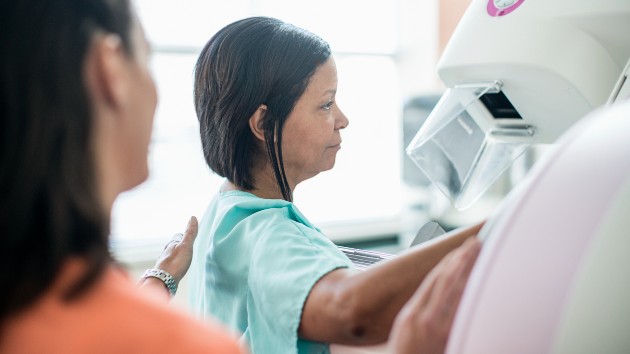(NEW YORK) — A study released in the Journal of the American Medical Association last week has shed some new light on how breast cancer rates have been disproportionately affecting Black female patients and pressed for earlier screenings.
The study found that Black women had the same risk of dying from breast cancer if they were screened starting at age 42 as the general population had with screenings starting at the recommended age of 50.
Researchers, who examined data from 415, 277 breast cancer deaths between 2011 and 2020, found that breast cancer death rates for women between 40 and 49 were highest among Black female patients, with a rate of 27 deaths per 100,000.
“These findings suggest that health policy makers and clinicians could consider an alternative, race and ethnicity-adapted approach in which Black female patients start screening earlier,” the authors wrote.
Although the researchers noted that there is “currently insufficient data to make specific recommendations for different racial and ethnic populations,” they said that race and ethnicity need to be factored in to “optimize the benefit of screening.”
The study didn’t prospectively test what would happen if screening started earlier, but instead used the data to calculate a risk threshold for breast cancer based on the screening age.
For screenings that started at 50, Black female patients reached that threshold for breast cancer at 42, while non-Hispanic white females did so at 51, American Indian and Alaska Native and Hispanic females at 57 years, and Asian and Pacific Islander females at 61, according to the study.
For screenings that started at 40, Black females would reach the risk threshold level at 34, white females at 41, Hispanic, American Indian or Alaska Native and Asian or Pacific Islander females at age 43 years, researchers said.
Researchers acknowledged their study didn’t look at the possible risks of earlier breast cancer screening for various races and ethnicities, such as false positives and the mental and emotional toll of waiting for test results.
“Although Black women may experience disproportionate rates of false positives because of breast density, the added risk of false positives from earlier screenings may be balanced by the benefits associated with earlier [breast cancer] detection in this group,” researchers said.
The report concluded that to decrease breast cancer mortality, “the starting age for the general population could be decreased from 50 to 45 or 40 years like what is done for colorectal cancer screening in the U.S,” and “health policy makers may consider the alternative, risk-adapted approach in which individuals, such as Black females, who are at high risk are screened earlier.”
Several organizations have different recommendations for breast cancer screenings.
The United States Preventive Services Task Force says women ages 50 to 74 should get a mammogram every two years, and women 40 to 49 should talk to their doctors about mammograms.
The American Cancer Society, which found that Black women have the lowest five-year relative breast cancer survival rate compared to all other racial/ethnic groups, recommends that women at mean risk levels should start annual mammography screening from age 45 years but have the opportunity to start from age 40 years.
Dr. Arif Kamal, the chief patient officer of the American Cancer Society, told ABC News that more research is showing a trend of younger women being diagnosed with breast cancer, and earlier screenings that are tailor-made based on a patient’s race, may be needed.
“I think it highlights beyond race, people should evaluate their own risk of breast cancer, such as family history and the age at which they were diagnosed,” he told ABC News.
Copyright © 2023, ABC Audio. All rights reserved.












